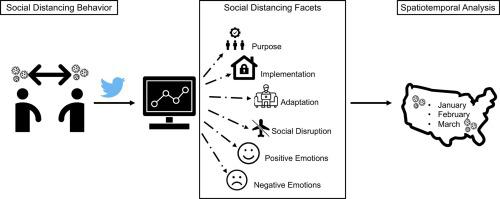Journal of Biomedical informatics ( IF 4.0 ) Pub Date : 2020-10-14 , DOI: 10.1016/j.jbi.2020.103601 Jiye Kwon 1 , Connor Grady 2 , Josemari T Feliciano 3 , Samah J Fodeh 4

|
Objectives
Using Twitter, we aim to (1) define and quantify the prevalence and evolution of facets of social distancing during the COVID-19 pandemic in the US in a spatiotemporal context and (2) examine amplified tweets among social distancing facets.
Materials and methods
We analyzed English and US-based tweets containing “coronavirus” between January 23-March 24, 2020 using the Twitter API. Tweets containing keywords were grouped into six social distancing facets: implementation, purpose, social disruption, adaptation, positive emotions, and negative emotions.
Results
A total of 259,529 unique tweets were included in the analyses. Social distancing tweets became more prevalent from late January to March but were not geographically uniform. Early facets of social distancing appeared in Los Angeles, San Francisco, and Seattle: the first cities impacted by the COVID-19 outbreak. Tweets related to the “implementation” and “negative emotions” facets largely dominated in combination with topics of “social disruption” and “adaptation”, albeit to lesser degree. Social disruptiveness tweets were most retweeted, and implementation tweets were most favorited.
Discussion
Social distancing can be defined by facets that respond to and represent certain events in a pandemic, including travel restrictions and rising case counts. For example, Miami had a low volume of social distancing tweets but grew in March corresponding with the rise of COVID-19 cases.
Conclusion
The evolution of social distancing facets on Twitter reflects actual events and may signal potential disease hotspots. Our facets can also be used to understand public discourse on social distancing which may inform future public health measures.
中文翻译:

在 COVID-19 大流行期间定义社交距离的各个方面:Twitter 分析
目标
使用 Twitter,我们的目标是 (1) 在时空背景下定义和量化美国 COVID-19 大流行期间社会疏远方面的流行和演变,以及 (2) 检查社交疏远方面中放大的推文。
材料和方法
我们使用 Twitter API 分析了 2020 年 1 月 23 日至 3 月 24 日期间包含“冠状病毒”的英语和美国推文。包含关键词的推文被分为六个社交疏远方面:实施、目的、社会破坏、适应、积极情绪和消极情绪。
结果
分析中总共包含了 259,529 条独特的推文。从 1 月下旬到 3 月,社交疏远推文变得更加普遍,但在地域上并不统一。社会疏远的早期方面出现在洛杉矶、旧金山和西雅图:首批受 COVID-19 疫情影响的城市。与“实施”和“负面情绪”方面相关的推文在很大程度上与“社会破坏”和“适应”主题相结合,尽管程度较低。社会破坏性推文被转发最多,实施推文最受欢迎。
讨论
社交距离可以通过响应和代表大流行中的某些事件的方面来定义,包括旅行限制和不断增加的病例数。例如,迈阿密的社交疏远推文数量很少,但随着 COVID-19 病例的增加,3 月份有所增加。
结论
Twitter 上社交距离方面的演变反映了实际事件,并可能预示着潜在的疾病热点。我们的方面还可用于理解关于社会疏远的公共话语,这可能会为未来的公共卫生措施提供信息。









































 京公网安备 11010802027423号
京公网安备 11010802027423号